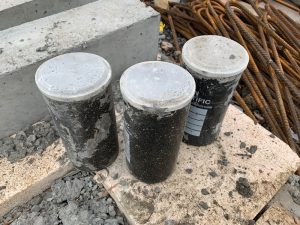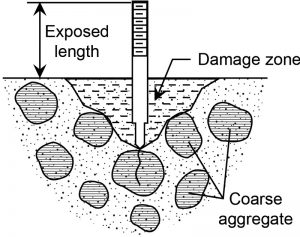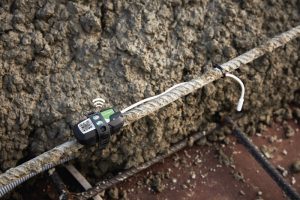As a general contractor or subcontractor working on a concrete structure, one of the most important tasks is ensuring that the concrete has been properly cured and its quality has been tested according to applicable standards. This is of the utmost importance for quality control and quality assurance purposes. Equally important is selecting an appropriate and accurate method for monitoring the strength of in-place concrete. Unfortunately, popular methods of testing concrete quality, especially compressive strength, are frequently subject to discrepancies.
Cylinder Break Tests
If the project is anything like most other concrete construction sites, break tests are likely used to monitor the strength of newly placed concrete. This practice has remained mostly unchanged since the early 19th century. There are two types of specimens that field technicians collect to test the strength of concrete: standard-cured cylinders and field-cured cylinders. These samples are cast and cured according to ASTM C31, Standard Practice for Making and Curing Concrete Test Specimens in the Field, and are tested for compressive strength, most often by a third-party testing laboratory.
As the name suggests, field-cured cylinders are subject to the same temperature and relative humidity conditions that the completed structure will experience in its environment. Unlike standard-cured cylinders, field-cured specimens are kept right beside the concrete slabs on site. They are predominantly used for determining whether a structure is ready for critical operations like removing formwork or post-tensioning.
In standard or lab curing, concrete cylinders are sent to the lab where they are stored in curing tanks or rooms which are subjected to curing conditions outlined in the ASTM standard and the project’s specifications. Standard-cured cylinders are generally tested 28 days after the concrete is placed for quality control and standard acceptance purposes.
Although cylinder break tests are the most widely accepted method of compressive strength testing, they are frequently associated with testing discrepancies that are not often genuinely representative of in-situ concrete elements. Curing conditions, the surface area of the cylinders compared to the onsite concrete element, and transportation to the laboratory of field-cured specimens are all factors that can skew the setting, hardening, and strength performance of the samples in comparison to the actual structural elements made from the same concrete material.
Standard-Cured Cylinders
Even though the process of testing cylinders is fully standardized, there has been a considerable amount of “bad” or low breaks recorded when standard specifications are not properly followed on site. The American Concrete Institute’s (ACI) pertinent specifications (ACI 318-14, 301-16, and 311.6-09) state that acceptance test specimens need to be standard-cured in accordance with ASTM C31. After the cylinders are molded, ambient temperature and humidity are to be monitored and maintained. Test specimens are required to be stored in a temperature range of 60°F to 80°F (16°C to 27°C) for a period of up to 48 hours (subject to change based on the type of concrete). Moisture and relative humidity loss are prevented by storing the samples in a moisture-filled environment, which is typically a cooler installed on site. Improper temperature and relative humidity control at the initial stages of the cylinder life can result in inaccurate strength data when testing occurs at later ages. Furthermore, as standard-cured cylinders are subject to these strict curing conditions, they largely do not reflect the in-situ concrete but rather verify the QA/QC of the concrete’s mix design to ensure it meets specifications.
Field-Cured Cylinders
On most construction sites, field-cured concrete samples are tested for strength at various ages during the first week after the concrete is poured to decide when to allow formwork removal. Usually, if the concrete reaches 75% of its designed strength, the structural engineers allow for the stripping of forms.
If samples are not properly prepared and rodded according to ASTM standards, there may be voids or aggregate segregation in the samples. As a result, the concrete cylinder will have a lower measured strength when compressed.
Furthermore, despite being placed near concrete elements on site, field-cured cylinders are often not subject to the same ambient conditions as placed concrete; test cylinders are often kept in the shade or a trailer. As a result, the strength value when the cylinder is broken will not represent that of the actual structure, affecting its quality in the long run. A main contributing factor to this is the surface area and size of the placed concrete in comparison to the field-cured cylinders. This difference significantly alters the curing temperature of field-cured specimens, affecting their ability to represent the placed concrete.
Following the initial curing onsite, the specimens for standard-cured and field-cured are transported to the laboratory. Due to their relatively low strength, early-age specimens are highly susceptible to mechanical damage if not protected from jolting, which is typically experienced during transportation. Improper handling of specimens, especially at an early age, makes them more vulnerable and susceptible to micro-cracking. Therefore, when the samples are broken, these voids created by the micro-cracking affect the strength value tested, resulting in a low cylinder break that does not represent the strength of the in-situ concrete.
ASTM C31/C31M outlines the details for the safe transport of the specimens, with transportation time not exceeding 4 hours. These specimens need to be monitored for exposure conditions during the transport phase. This includes protection from freezing with efficient insulation materials, including; being wrapped in plastic, wet burlap, or surrounding them with wet sand to prevent moisture loss.
Even when handled with caution, transportation is still an issue. Test specimens that are placed in the back of trucks with no plastic caps or cushioning are subject to moisture loss and structural integrity. Although transportation is not a technical process, it is an essential step in ensuring the laboratory receives quality test specimens.
After the concrete specimens have been curing for a specific number of days [3, 7, 14 days], they are prepped by the lab for breaking. This involves either grinding the ends of the cylinder so that they are parallel or capping them. Grinding the ends of a break is done to ensure continuity in contact while the load is applied. Capping cylinders, according to ASTM C617, is utilized when grinding is not possible. If the concrete cylinder is not prepared with care and attention before breaking, the cylinder will not properly break when a load is applied, and the strength value that results will, therefore, show up as a low break.
Alternative Methods
As a result of the discrepancies associated with concrete cylinder testing, alternative strength testing methods are used.
Rebound Hammer or Schmidt Hammer (ASTM C805)
A spring release mechanism is used to activate a hammer, which impacts a plunger to drive into the surface of the concrete. The rebound distance from the hammer to the surface of the concrete is given a value from 10 to 100. This measurement is then correlated to the concrete strength. A rebound or Schmidt hammer is relatively easy to use and can be done directly on site. However, pre-calibration using cored samples is required for accurate measurements. Additionally, test results can be skewed by surface conditions and the presence of large aggregates or rebar below the testing location.
Penetration Resistance Test (ASTM C803)
A device drives a small pin or probe into the surface of the concrete to complete a penetration resistance test. The force used to penetrate the surface and the depth of the hole is correlated to the strength of the in-place concrete. Penetration resistance test is also relatively easy to use and can be done directly on site. Data gathered using this technique is significantly affected by surface conditions as well as the type of form and aggregates used. Furthermore, pre-calibration is necessary using multiple concrete samples for accurate strength measurements.
Ultrasonic Pulse Velocity (ASTM C597)
This technique determines the velocity of a pulse of vibrational energy through a slab. The ease at which this energy makes its way through the slab provides measurements regarding the concrete’s elasticity, resistance to deformation or stress, and density. This data is then correlated to the slab’s strength. Ultrasonic pulse velocity is a non-destructive testing technique that can also be used to detect flaws within the concrete, such as cracks and honeycombing. Unfortunately, this technique is highly influenced by the presence of reinforcements, aggregates, and moisture in the concrete element. It also requires calibration with multiple samples for accurate testing.
Pullout Test (ASTM C900)
The main principle behind this test is to pull the concrete using a metal rod that is cast-in-place or post-installed in the concrete. The pulled conical shape, in combination with the force required to pull the concrete, is correlated to compressive strength. The pullout test is easy to use and can be performed on both new and old constructions. However, this test involves crushing or damaging the concrete. A large number of test samples are needed at different locations of the slab for accurate results.
Drilled Core (ASTM C42)
A core drill is used to extract hardened concrete from the slab. These samples are then compressed in a machine to monitor the strength of the in-situ concrete. These samples are considered more accurate than field-cured specimens because the concrete that is tested for strength has been subjected to the actual thermal history and curing conditions of the in-place slab. However, this is a destructive technique that requires damaging the structural integrity of the slab. The locations of the cores need to be repaired afterward. A lab must be used to obtain strength data.
Wireless Maturity Sensors (ASTM C1074)
This technique is based on the principle that concrete strength is directly related to its hydration temperature history. Wireless sensors are placed within the concrete formwork, secured on the rebar, before pouring. Temperature data is collected by the sensor and uploaded to an app in any smart device using a wireless connection. This information is used to calculate the compressive strength of the in-situ concrete element based on the maturity equation that has been set up in the app. Compressive strength data is given in real-time. As a result, the data is considered more accurate and reliable as the sensors are embedded directly in the formwork, meaning they are subject to the same curing conditions as the in-situ concrete element. This also means no time is wasted on site waiting for results from a third-party lab. However, testing concrete strength using the maturity method requires a one-time calibration, for each concrete mix, to establish a maturity curve using cylinder break tests.
Choosing the Right Test
Tests like the rebound hammer and penetration resistance technique, while easy to perform, are considered less accurate than other testing methods. This is because they do not examine the center of the concrete element, only the curing conditions directly below the surface of the slab. Practices, such as the ultrasonic pulse velocity method and the pullout test, are more challenging to perform as their calibration process is lengthy, requiring a large number of sample specimens to obtain accurate data. As destructive testing techniques, the drilled core and cast-in-place cylinder methods are more expensive and take longer to perform, resulting in more time needed in the project schedule. Comparatively, with the maturity method, strength data is available in real-time directly on site, allowing for well-informed and quick decision-making.
Decisions in choosing a testing method may simply come down to what the engineer is accustomed to and what information is needed. However, the accuracy of these tests and the time they take to obtain strength data are significant factors that are not always taken into consideration as comprehensively as they should. The accuracy of the chosen technique can lead to future durability and performance issues of the concrete structure. Furthermore, choosing a technique that takes additional time to receive strength data can be detrimental to project deadlines, negatively impacting productivity on the job site. Conversely, choosing the right tool can positively impact project timelines and allow the project to be completed below budget.■



